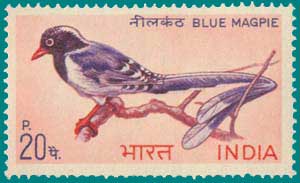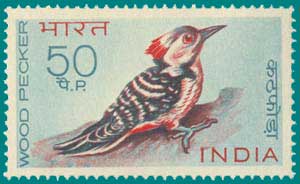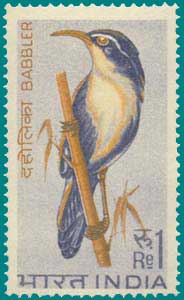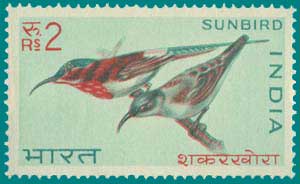INDIAN BIRDS
BLUE MAGPIE (Urocissa crythrorhyncha)
 This blue bird is about the size of a pigeon with the two central feathers of the tail 15 to 17 inches long. The head, neck and breast are black and underparts greyish white. The tail feathers are tipped white. The bill and the legs are crimson. The male and the female are alike. It is found throughout the Himalayas, upto an altitude of about 10,000 feet. This magpie is, a common bird at all West Himalayan hill stations. Its flight is noisy and slow, but with the long tail spread, a party in flight makes a charming spectacle.
This blue bird is about the size of a pigeon with the two central feathers of the tail 15 to 17 inches long. The head, neck and breast are black and underparts greyish white. The tail feathers are tipped white. The bill and the legs are crimson. The male and the female are alike. It is found throughout the Himalayas, upto an altitude of about 10,000 feet. This magpie is, a common bird at all West Himalayan hill stations. Its flight is noisy and slow, but with the long tail spread, a party in flight makes a charming spectacle.
BROWN-FRONTED WOOD- PECKER
(Dendrocopos auriceps)

This hill bird is about 8 inches long and is common in the forests of Western Himalayas, at elevations between 2000 and 7000 feet. Its back is cross-barred black and white. There is a red patch under the tail. The crown in the male is golden-brown in front, crirnson behind. The female lacks these colours on its head.
WHITE BROWED SCIMITER BABBLER (Pomatorhinus schisticeps)

A dark-brown bird with white throat and breast, prominent white eye-brows and curved pointed yellow bill, it is found in forested country throughout India. It is a medium-sized bird of a length slightly over 8 inches, the male and the female being alike. It is a shy bird, usually rummaging on the 'ground under dense under- growth for insects and grubs. Its flight is feeble and ill sustained. The male bird's call is flute-like with 4 notes.
CRIMSON SUNBIRD (Aethopyga Siparaja)

Of the size of a sparrow, this is a brilliantly coloured, purple, green and crimson sunbird, with a long pointed metallic green' tail and a distinctive yellow rump. It is found in moist evergreen forests throughout India. It flits about restlessly like a gem in the sunshine among shrubs, sometimes hanging upside down to probe into flowers for nectar. It also feeds on insects and spiders.
Date of Issue:
31.12.1968
 This blue bird is about the size of a pigeon with the two central feathers of the tail 15 to 17 inches long. The head, neck and breast are black and underparts greyish white. The tail feathers are tipped white. The bill and the legs are crimson. The male and the female are alike. It is found throughout the Himalayas, upto an altitude of about 10,000 feet. This magpie is, a common bird at all West Himalayan hill stations. Its flight is noisy and slow, but with the long tail spread, a party in flight makes a charming spectacle.
This blue bird is about the size of a pigeon with the two central feathers of the tail 15 to 17 inches long. The head, neck and breast are black and underparts greyish white. The tail feathers are tipped white. The bill and the legs are crimson. The male and the female are alike. It is found throughout the Himalayas, upto an altitude of about 10,000 feet. This magpie is, a common bird at all West Himalayan hill stations. Its flight is noisy and slow, but with the long tail spread, a party in flight makes a charming spectacle.

